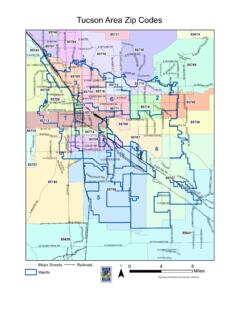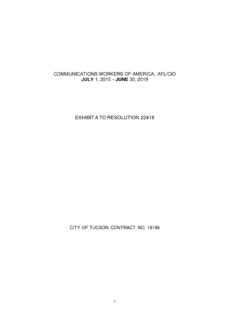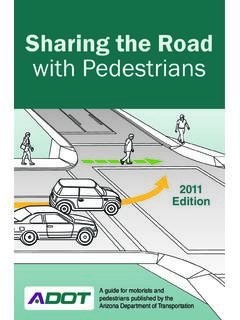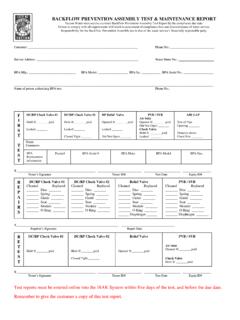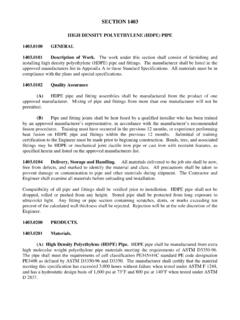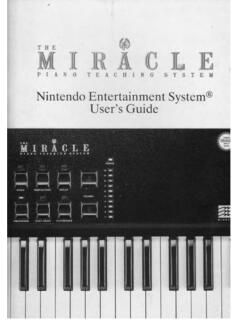Transcription of Historic Miracle Mile - Tucson
1 Throughout the middle of the 20th century, Miracle mile , Oracle Road, and Drachman Street were together known as Tucson s Miracle mile Strip. This was the northern segment of Tucson s primary automotive corridor: the vehicular route into the city from the North, a crossroads for those traversing the nation on Routes 80 and 89, and an economic arterial that fostered development in several regionally popular architectural styles. For many, this defined their Tucson experience; for others, it shaped their first impression of the Old Pueblo. Swimming pools, flickering neon and lush grassy courtyards welcomed visitors to motels with names like La Siesta, El Rey, Frontier, and El Rancho. Restaurants served steak and music for under $ Today, these iconic buildings and glowing signs have emerged from history to provide a persistent reminder of the continuing American fascination with the Automobile, and to enhance our society s understating of the mythic 20th century West.
2 Classic neon signs still evoke an era of fast cars and a slower pace of life. These wonderful examples of mid-20th century commercial art are an evocative night storic Miracle Mile3El Rancho Motor HotelCopper Cactus Inn 225 W. Drachman hotel was built by Louise and Bess Barrasso. The 20th Century Revival style property consists of two buildings in an integrated row-on-row arrangement. The interior courtyard was originally a garden; now it is used primarily for parking. The original swimming pool has been maintained. The original monument neon sign of a cowboy and lasso has been AAA Branch Office Creative Awards 234 W. Drachman single-story round building was constructed in 1960. The exterior surface is red brick and topped with a circular roof that overhangs the entire building. The roofline is a series of identical gables, the peaks of which radiate from the center creating a highly idiosyncratic modern form. Two gables of this pleated roofline extend over the entrance and at the rear of the building.
3 6 Executive Inn and Suites333 W. Drachman by Phoenix architect Barrie Greon, the luxury 150 room motel was constructed at a cost of $ million and opened February 14, 1961. The building has undergone substantial renovations and alterations, including faux dormers added to the parapet of the front fa ade. The original sign has been replaced but the base of the monument sign is Tucson House 1501 N. Oracle The 17-story reinforced concrete and brick Tucson House was featured in Time Magazine and TV Guide. Rep. Morris K. Udall was a resident for two years during the 1960s. In the mid 1970s, occupancy declined; the property was auctioned in October 1976 to HUD, which provided a grant to the City of Tucson to purchase it. By August 1986, $4 million renovations were completed, creating 100 subsidized apartments. The building continues with this use today. 8 Gateway Saguaro Public Art ProjectSummer 2009 Dirk Arnold s design for this oversized neon sculpture draws from the visual lexicon of vintage neon signs the 1940s, 50s and 60s.
4 Created in the form of a saguaro cactus, the 30 ft. monument is a fresh glowing icon of Tucson and Miracle mile . 9 Tucson Hiway House Motor Hotel Stadtler Hilton HotelCollege Place1601 N. Oracle 200 room two-story courtyard motel developed by New York City investors on a nine-acre site at a cost of $ million was leased and operated by the Del Webb chain. Amenities included a dining room, coffee shop, cocktail lounge, and a narrow gauge miniature railroad ride in the parking lot. It was the second hotel in Arizona to install direct dial telephone service. The 120,000+ sq. ft. building has undergone modifications and rehabilitation. It now functions as student residences with a caf , cantina and public meeting Well No. 2 Sparkle Cleaners 2 W. Drachman Originally designed by Tucson architect Cecil H. Moore to house a dry cleaning business, this modern-style, red brick single-story, square building has remained relatively unaltered. Air vents for the dry-cleaning machinery are integrated into the south wall of the fa ade in a geometrical, decorative pattern.
5 The original neon monument sign is extant. 10La Siesta Motel 1602 N. Oracle by Mr. and Mrs. Wayne Mehl during the mid-twentieth century, this one-story L-shaped building was constructed in a revival style with exposed red brick and low-pitched, hipped Spanish tile roofing. Recent restoration of the property included work on exterior surfaces, the re-establishment of the central lawn and garden area, and renovation of the original swimming pool. 11De Luxe MotelStarline Motel Quail Inn 1650 N. Oracle De Luxe Motel was built in the Spanish Revival style by Mr. and Mrs. C. A. Dunlap and was part of the first national motor hotel association. After WWII, it was expanded and renamed the Starline Motel. The carports were converted to units, and the stylized Spanish Revival details masked behind a simplified flat fa ade. The neon Vacancy sign on a plinth of glass blocks in a classic Art Deco motif, is assumed to be original. 2 Tucson Inn143 W.
6 Drachman Built between 1952-55, Tucson Inn originally consisted of two concentric U-shaped, two-story buildings. The outer ring has been demolished, but the inner ring remains intact and fully functional. The large, one-story north-facing office building included the lobby and a restaurant and bar. The restaurant sign has been painted out and neon tubing removed. The massive entrance sign, a Tucson icon, is illuminated at night. 4 Frontier Motel227 W. Drachman The Frontier was built in a 20th Century Revival style with a 1965 addition at the rear. Ornamentation includes exposed red brick, carved wooden columns, and red concrete floors. This property has remained intact and is a fine example of an early highway motor court. The original neon sign illuminates at night. 12 Green Lantern Caf Ye Olde Lantern Tucson Elks Lodge #385 1800 N. Oracle constructed in 1938 as the Green Lantern Caf , the building was remodeled and renamed by Dean and Millie Short in March 1959 to Ye Olde Lantern, with Eddie Dugan entertaining at the Piano Bar.
7 In 2007, the building was purchased and remodeled by the Tucson Elks Lodge #385. Bill, the bronze elk that resides atop the roof was cast in 1903. The restaurant sign was removed during remodeling, but its remains are on display on North 10th Avenue, just north of University Blvd. 13 Highland Tower Motel 1919 N. Oracle This 24-unit Spanish Revival motel was constructed in an open U-shaped plan. The original neon sign (now lost) was conceived as a flag attached to the two-story office/owner s-residence at the east end of the south wing. The original swimming pool, ramada, and adjacent trees are original, although the lawn has been removed. There have been almost no alterations to the form and details of this Casa Linda Motel, El Sahuaro Motel, Silver Saddle Motel, Paul s Hideaway Lodge and Las Flores Motel200 Block of W. Flores 1947-1960 This cluster of five small motor courts has remained relatively unscathed by time and economic downturn.
8 Although the neon signs no longer glimmer, the gardens are overgrown or removed, and the properties are rented as apartments, the overall form and character of these motor courts survive. The figurative Casa Linda Motel neon sign was partly painted out in Pago Restaurant and Cocktail LoungeStarbuck Design2201 N. Oracle in the 1956 MGM movie A Kiss Before Dying, the one-story, rectangular building featured a circular entrance porch designed to evoke a South Pacific palapa, heavily decorated with faux Polynesian deco murals. Large individual neon letters spelled out Pago Pago on both the east and north walls. The lounge featured a long, curving outdoor bar and irregularly arranged booths. In the late 20th century the building was heavily modified but the original palm trees survived. 16 Oracle Motel Tiki Motel2649 N. Oracle Constructed by Mr. and Mrs. Luther R. Campbell, the one-story flat-roofed, simplified Pueblo Deco complex featured exposed red brick buildings and attached carports with slightly lower roofs.
9 The original landscaped court and classic Art Deco sign were lost by the late mid-20th century, when the property was renamed the Tiki Motel and a sign in the shape of a Polynesian war shield and mask, outlined with neon, was Biltmore Motor Hotel(Demolished)2775 North Oracle Tucson Biltmore Motor Hotel was designed by modernist Tucson architect Arthur T. Brown and built by Paul Robinson; the landscaping was designed by John Harlow. The entire project was constructed at a cost of $500,000. The Biltmore featured a circular restaurant with picture windows above its office/lobby and a large neon sign of a abstracted SunLand Motel465 W. Miracle Mile1949 This well-preserved 20th Century Revival single-story motel is still in operation. All of the buildings were constructed in a simplified Spanish Revival style. A small swimming pool is extant; the original landscaping, which included a lawn across the front of the property and cactus garden is now paved parking Motor Lodge515 W.
10 Miracle Mile1953 The office/owner s-residence at the front of the eastern building has unique floor-to-ceiling mullioned picture windows on the north and west sides angling outwards. Original-design brick details including the curved staircase are still present. The streamlined Moderne sign originally extended toward the roadway from a steel post which rose from a brick plinth in a small reflecting pool. The sign is now taller and projects away from the street. While the water feature under the sign is lost, the original palm trees and swimming pool are still present in the courtyard. 21 Terrace Motel631 W. Miracle Mile1949 Mr. and Mrs. William Goldfield built the Terrace Motel in 1949, with additions in 1952 and 1958. The boxy modernist motel is defined by a front office which features a large extension of the roof supported by a column of specially cast concrete blocks with faux Mayan pictograms. Incorporated into this sculptural element are the letters W, O, and G for William O.
